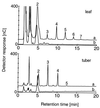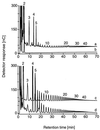Transgenic potato (Solanum tuberosum) tubers synthesize the full spectrum of inulin molecules naturally occurring in globe artichoke (Cynara scolymus) roots
- PMID: 10890908
- PMCID: PMC27011
- DOI: 10.1073/pnas.150043797
Transgenic potato (Solanum tuberosum) tubers synthesize the full spectrum of inulin molecules naturally occurring in globe artichoke (Cynara scolymus) roots
Abstract
The ability to synthesize high molecular weight inulin was transferred to potato plants via constitutive expression of the 1-SST (sucrose:sucrose 1-fructosyltransferase) and the 1-FFT (fructan: fructan 1-fructosyltransferase) genes of globe artichoke (Cynara scolymus). The fructan pattern of tubers from transgenic potato plants represents the full spectrum of inulin molecules present in artichoke roots as shown by high-performance anion exchange chromatography, as well as size exclusion chromatography. These results demonstrate in planta that the enzymes sucrose:sucrose 1-fructosyltransferase and fructan:fructan 1-fructosyltransferase are sufficient to synthesize inulin molecules of all chain lengths naturally occurring in a given plant species. Inulin made up 5% of the dry weight of transgenic tubers, and a low level of fructan production also was observed in fully expanded leaves. Although inulin accumulation did not influence the sucrose concentration in leaves or tubers, a reduction in starch content occurred in transgenic tubers, indicating that inulin synthesis did not increase the storage capacity of the tubers.
Figures



References
-
- Wagner W, Keller F, Wiemken A. J Plant Physiol. 1983;112:359–372.
-
- Frehner M, Keller F, Wiemken A. J Plant Physiol. 1984;116:197–208. - PubMed
-
- Hendry G A F. New Phytol. 1987;106:201–216.
-
- Pontis H G. Methods Plant Biochem. 1990;2:353–369.
-
- Carpita N C, Keller F, Gibeaut D M, Housley T L, Matile P. J Plant Physiol. 1991;138:204–210.
Publication types
MeSH terms
Substances
LinkOut - more resources
Full Text Sources
Other Literature Sources

